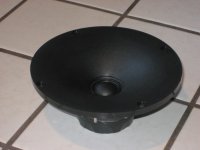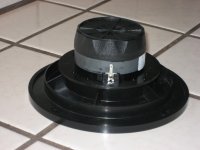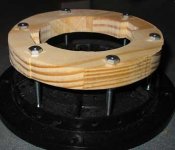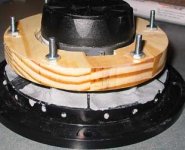GM said:Greets!
Last, but not least, DR tweeters can't handle much loading (at least none I tried it on), so I wouldn't waste any time designing a speaker until you've proven that the desired tweeter can handle the loading with low distortion at its rated power without rolling off its extreme HF.
GM
I've been thinking about this comment for a while, since I'm planning on trying one of these, and am working on getting my head around the important concepts.
So, what I think you're saying is... "regular" tweeters can't handle much loading without developing extra distortion at high levels. "Loading" being the effect of the different impedence transformation (also translated as more force on the dome) of the waveguide.
So if that's the case, at some point, the lighter (and lower distortion) loaded tweeter due to the increased efficency of the WG may turn into the deforming dome, suddenly increased distortion tweeter when a certain level is reached. And that would depend on how much loading your particular WG applies, as well as much the particular dome can resist the increased load.
I notice that true horn/compression drivers have really heavy (in comparison to DR drivers) metal diaphrams.. probably to help hold up to the large loading of a true horn. That got me thinking that metal dome DR tweeters might be better choices for horn experiments due to the stiffer domes.
Anyway, this is a theoretical thought chain.. and I may be barking up the wrong garden path... but if that's how it works we'd probably get a lot more headroom out of a metal dome. Or not... ;-)
My other thought was that it might be nice to know how close we get to the distortion/overloading point with John's current shallow WG and the TDFC. And, that it might be an interesting enough experiment for John, busy guy that he is, to do some distortion runs at increasing volume levels and see what happens...
One of the cool things (I think) about the WG TMM design is the HUGE dynamic range potential, with the high efficency and large power handling capability. I think it would be interesting to see how far the tweeter section can go, before (or if!) the distortion starts to rise up.
Who knows... if I get less hammered by my work, and I get off my butt, I might have a 27TBFC with WG to add to the data in the not to distant future....
Ok, i've scrapped my previous project because I've become too attracted to the waveguide. I'm still interested in the series xoveer though, I'm wondering what types of series xovers would work with the waveguide and how the waveguide would affect the sonic differences in the xovers. Since the basic crossover design is so simple though i could expiriment with other types of networks but not have to wait on speaker completion. I'm still a total novice with network design and would welcome any pointers from gurus.
... from a cursory sweep of tweeter-waveguide designs on the web (and Zaphs is the only diy I could find) their use seems almost exclusive to near-field "studio monitor" designs. A couple of companies even have "professional" studio monitors with waveguides in their lineup, while remaining with the straightforeward baffle-mounted tweeters in their consumer hifi lineup. Any comparison by cost would seem to have no bearing. ATC was one example.
Are waveguided tweeters (by this unscientific inference at least) best suited to near-field listening? I can find nothing but praise for the advantages they offer, so... Ok, here it comes... why aren't they more common? Studio monitors using them have been around for many years as an example to designers and diy'ers. It's not as if everyone is just waking up to them.
And from another non-scientific angle... waveguide tweeters are just damn good looking. Zaphs TMM has, to my eye, some of the most elegant, functionally pure lines I've seen on a speaker. It just LOOKS like it's got to sound wonderful. I almost wouldn't mind having it in my living room on that basis alone!
Are waveguided tweeters (by this unscientific inference at least) best suited to near-field listening? I can find nothing but praise for the advantages they offer, so... Ok, here it comes... why aren't they more common? Studio monitors using them have been around for many years as an example to designers and diy'ers. It's not as if everyone is just waking up to them.
And from another non-scientific angle... waveguide tweeters are just damn good looking. Zaphs TMM has, to my eye, some of the most elegant, functionally pure lines I've seen on a speaker. It just LOOKS like it's got to sound wonderful. I almost wouldn't mind having it in my living room on that basis alone!
Waveguide TMM
Hi,
Im' in the process of building Johns TMM. On his cabient drawings he shows the raised baffel on the front that is removeable, which I like. The question I have is could you add another baffle to the bottom just to make the front flush, or would this change the sound. Going to use tube amps.
Thanks,
Moochie
Hi,
Im' in the process of building Johns TMM. On his cabient drawings he shows the raised baffel on the front that is removeable, which I like. The question I have is could you add another baffle to the bottom just to make the front flush, or would this change the sound. Going to use tube amps.
Thanks,
Moochie
Genelec use the Seas 27mm aluminium dome in a waveguide on their 1032 active monitors, its crossed VERY low and sounds pretty nasty to me. Just my observation, from memory its crossed over around 1kHz on a very steep slope (someone blew a tweet and I MLSSA'd the monitor with duff tweet).
bluebeard
Are waveguided tweeters (by this unscientific inference at least) best suited to near-field listening?
Waveguides are control directivity devices. If the goal of your design is controlled directivity (like a dipole), a waveguide will help achieve this, whether near field or far field.
Probably the same reason why it seems like 95% of DIY designs, websites, events,etc. feature speaker systems with 2,3,4 etc drivers on the face of a box. Much like you would find in the aisles of Best Buy. I honestly don't know why this would be. Perhaps because that's what most are comfortable building?bluebeard
why aren't they more common?
Cheers,
AJ
An externally hosted image should be here but it was not working when we last tested it.
bluebeard said:... from a cursory sweep of tweeter-waveguide designs on the web (and Zaphs is the only diy I could find) their use seems almost exclusive to near-field "studio monitor" designs. A couple of companies even have "professional" studio monitors with waveguides in their lineup, while remaining with the straightforeward baffle-mounted tweeters in their consumer hifi lineup. Any comparison by cost would seem to have no bearing. ATC was one example.
Well, interestingly enough, a while ago I went to check my local Best Buy.. after hearing that they have a "high end" AV store attached to some. Sure enough, you CAN find Martin Logan speakers at a Best Buy..

The thing I noticed, is that MOST of these "upper shelf" Energy, Paradigm, etc, speakers, had some kind of shallow to deeper horn like mountings for their tweeters, very few were flat on the baffle.
Maybe they know something? Better directivity in a HT setup? This year's speaker fad? Easier to make halfway decent sounding two component crossovers? All of the above?
Anyway, it was interesting to see them popping up after getting interested in them on the DIY side..
On another depressing note, Zaph has noted on his site that the MCM horns seem to be out of stock... damn, I wanted to get some!
Guess we need to think about DIY horns, finding MCM's original source, or has anyone heard anything about the supposed Finnish horns that are made for the TDFC/TBFC's??
If the optimum profiles could be found online and downloaded/printed it would be pretty easy to duplicate a wave guide on my wood lathe. The end result might even work better than cutting down the mcm part. Mounting the tweeter to the rear would be easier done with the larger surface available on the back of a solid lathe-cut block.
But lathes may not be a very common diy option for many.
But lathes may not be a very common diy option for many.
New Tweeter mounting
Time to revive this thread !!
I have been building Zaph's waveguide TMM the last two weeks.
Just finished the tweeter mounting with a new twist (see pics) !!
The TDFC tweeter has been bonded in place with epoxy.
The type of epoxy is critical (I used high impact golf shaft epoxy) but something that has a good bond and is not brittle should work !!
I find this was easier than the original method and may be what keeps many from this design ??
I'm using the madisound 38 Liter box with some extra beefing up/cross supports.
I'll post more when I'm done....
Todd
Time to revive this thread !!
I have been building Zaph's waveguide TMM the last two weeks.
Just finished the tweeter mounting with a new twist (see pics) !!
The TDFC tweeter has been bonded in place with epoxy.
The type of epoxy is critical (I used high impact golf shaft epoxy) but something that has a good bond and is not brittle should work !!
I find this was easier than the original method and may be what keeps many from this design ??
I'm using the madisound 38 Liter box with some extra beefing up/cross supports.
I'll post more when I'm done....
Todd
Attachments
I had not seen this thread before.
I am just now completing a very effective DIY speaker with a 10" woofer and a 10" waveguide. Perhaps I'll post some results to DIY.
For those who are dsicovering the benefits of waveguides I would add that this is the only way to control directivity. Piston sources do not and cannot have controlled directivity.
As you work through designs more and more you will find that narrower directivity has very large advantages in small rooms. As the directivity gets narrower the wavguide gets more compact and a compression driver begins to look attractive since a dome at the bottom of a narrow waveguide will generate a lot of HOM.
Thi is how I found myself where I am today. Its a logical progression.
I am just now completing a very effective DIY speaker with a 10" woofer and a 10" waveguide. Perhaps I'll post some results to DIY.
For those who are dsicovering the benefits of waveguides I would add that this is the only way to control directivity. Piston sources do not and cannot have controlled directivity.
As you work through designs more and more you will find that narrower directivity has very large advantages in small rooms. As the directivity gets narrower the wavguide gets more compact and a compression driver begins to look attractive since a dome at the bottom of a narrow waveguide will generate a lot of HOM.
Thi is how I found myself where I am today. Its a logical progression.
I took the waveguide and made a jig to hold bolts in place in the correct locations, with a nut on top and below the jig it can be positioned high enough to put epoxy in to hold the bolt heads, I ruffed up the surface with a Dremmel tool and drilled small holes to help hold the epoxy. Oatly epoxy comes in a roll, cut the portion and knead to mix. Then with jig removed just set the tweeter in place, put on the jig and secure with nuts. Tweeters can be removed , switched and reinstalled without removing thre baffle.
Attachments
Zaph sums it up well here:
http://www.zaphaudio.com/hornconversion.html
Though some may quibble with the horn vs. waveguide nomenclature, the point is made through the measurements.
Regards,
David
http://www.zaphaudio.com/hornconversion.html
Though some may quibble with the horn vs. waveguide nomenclature, the point is made through the measurements.
Regards,
David
blue934 said:can someone describe in brief, what is the advantages of a waveguide?
thanks
blue934
In brief - it helps to control the directivity.
I was the first person to use this term in this regard in 1990 when I gave a paper entitled Acoustic Waveguides. The reason for the use of this new term, as opposed to horns, is well explained in the "Letter To the Editor of Audio X Press" at my website www.gedlee.com.
Its usage today has gotten completely away from my usage and basically people seem to be using whenever they feel like it.
gedlee said:
In brief - it helps to control the directivity.
I was the first person to use this term in this regard in 1990 when I gave a paper entitled Acoustic Waveguides. The reason for the use of this new term, as opposed to horns, is well explained in the "Letter To the Editor of Audio X Press" at my website www.gedlee.com.
Its usage today has gotten completely away from my usage and basically people seem to be using whenever they feel like it.
Taken from that little "horn conversion" article I posted:
So, There do appear to be some benefits for this particular arrangement:
- True 2nd order slopes with a simple filter
- Acoustic center moved back about 1.5" for easier listening axis positioning
- Lower harmonic distortion
Notice that I didn't even mention directivity. Of course there is some directivity inherent to a 6" diameter round profile waveguide but the three items I just listed were more important to me.
Rest assured that I didn't choose this particular wave guide for this design without good reason or just because "I felt like it." It suits the design well and helped me reach my goals.
- Status
- This old topic is closed. If you want to reopen this topic, contact a moderator using the "Report Post" button.
- Home
- Loudspeakers
- Multi-Way
- Waveguide TMM Posted



